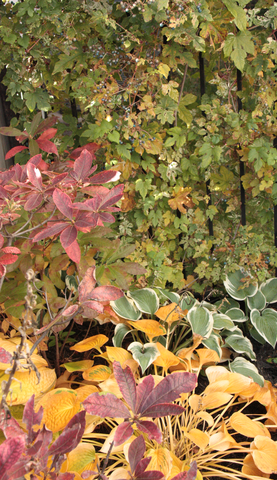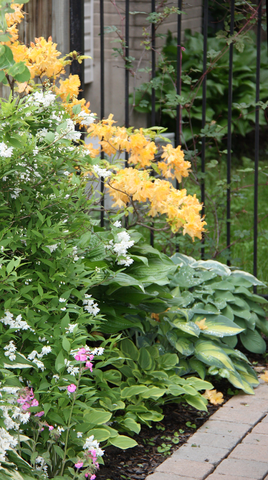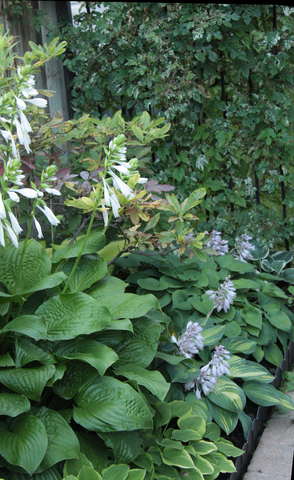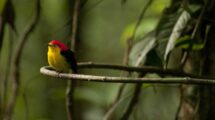The Joy of a Garden that Keeps on Giving
Story and Photos by Penka Matanska
A thriving garden is one that is well maintained, cared for and planned and planted for all stages throughout the season. Every gardener agrees that a good-looking all-season garden is not an overnight success. Behind a garden’s magic, there are years of dedicated work. Proper planting, together with long-term maintenance, is the key to an exuberant living space that has character and charm and keeps its interest in spring, summer and fall.

My first thoughts in the planning of a new garden area are to establish the places for the largest elements: the trees or shrubs. They give a maturity and lasting presence to a space, so finding the right place for them is important. When the proper light and growth conditions are met, a shrub or a small tree will serve as a vibrant element to enjoy over time. Vines also take a long time to establish and require a trellis or a fence to climb on so their placement should be planned well ahead. Smaller plants are better planted in the front of the garden bed and are easier to move if the light conditions change or they outgrow the space.
Simple plant combinations can have huge visual impact over the seasons if blooming periods are timed appropriately. I achieved that in a small semi-shade garden patch with only three types of plants.
I experimented with azaleas, porcelain berry vine (Ampelopsis brevipedunculata) and hostas in this semi-shade corner by a west-facing wall. Providing year-round interest is a difficult task. To get the bloom sequence right, it takes some planning and knowledge of the blooming times in your zone. As every garden creates a unique microclimate, the blooming times can vary from what is specified by the plant growers, so I took the approach of trial-and-error experimenting.

Remember: Not all combinations have to include flowers; a dynamic effect can be achieved with rich foliage colours and shapes. I planned for the shrub locations first and chose a Northern Lights azalea for spring and fall interest. It is important to follow the suggestions on the nursery tag for the mature size of the plants to allow for each bush to grow without crowding. I started the first year by planting two azaleas in early spring, so the blooming time could be established. At the same time, also in early spring, I added the porcelain berry vine by the metal fence. This vine was more of an experiment, as I didn’t know how it would integrate with the rest of the plants, but surprisingly, it brought not only vertical interest, but rich yellow hues in the fall along with purple/blue berries.
Hostas are reliable and hardy perennials that come back even after a hard winter. They are clear winners for a shady spot, providing interest in leaf texture and colour. There are a lot of hostas to choose from. I was looking for hostas blooming in different colours with unique leaf variegations and shapes. Finally, I settled on five. I chose Aphrodite for the large green leaf mass and white fragrant flowers that attract pollinators. June is one of my favourites, due to its multicoloured graceful leaves and small-stemmed mauve flowers that leave seed pods after blooming for further interest. Patriot brings a touch of white to the patch and Blue nicely contrasts with the others. The smallest leaf variety is Little Wonder, planted on the edge of the border to create a tiered effect.
The result: the spring blooming azalea contrasts beautifully with the hosta leaves. In the summer, the mauve and white blooms of the hostas complement the porcelain berry vine’s deeply lobed and spotted leaves. In late fall, the red foliage of the azalea and the yellow hues of the porcelain berry vine bring the best finale of the season. It turned out that with this simple plant combination, I was able to create a garden vignette that pleases me every time I look at it.
Transformation of plants can take many forms that extend garden interest. Observing these changes is rewarding and instantly makes any outdoor garden space more appealing. What is the secret to a successful garden that you can enjoy in every season? By putting in the effort to make a garden that speaks to you, you can reap the benefits for many years to come.

Characteristic Plant Features to Consider when Planning a Garden for All Seasons:
Foliage plays a central role in many stages of the garden landscape. Leaves come in different shapes and sizes and in many shades of green, sometimes with variegation. Some have different colours for emerging and/or fall foliage.
Flowers: Selecting plants with successive or alternating bloom times is a technique to make sure your garden has colour from spring to fall.
Flowers that mature in interesting ways provide changes to the garden that please the eye. Adding plants with attractive faded flowers, such as hydrangeas, or seedheads, such as the June hosta, can bring richness and complexity to the landscape.
Some plants may not have showy flowers, but instead form attractive fruits or interesting seed shapes that enrich a space.
Bark and stems are sometimes overlooked and need to be considered with a new eye, especially for fall and winter interest in the garden.
Tall grasses or the red stems of red osier dogwood (Cornus sericea), can provide an interesting visual effect and create shelter and food for local wildlife.
Penka Matanska takes great interest in creating urban garden settings and attracting pollinators and birds to her garden. She has been a member of the Master Gardeners of Ottawa-Carleton since 2019.






